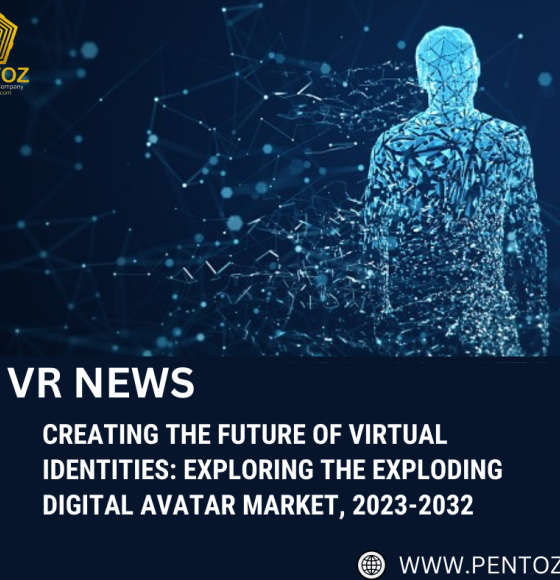Market Overview:
The market for digital avatars has grown as a vibrant and transformational industry, altering how people interact and represent themselves online. A digital avatar, which is frequently a graphical representation of a person or their embodiment, has quickly acquired popularity across a wide range of sectors and uses, transforming entertainment, communication, marketing, education, and more.
The following factors are fueling the market’s expansion:
The growing acceptance of virtual and augmented reality:
Two technologies that are gaining popularity are virtual reality (VR) and augmented reality (AR). AR superimposes digital data over the real world, whereas VR immerses users in a fully immersive environment. Both VR and AR apps can make use of digital avatars to provide consumers a more immersive and realistic experience.
The expanding desire for individualized experiences:
Customers are wanting more individualized experiences. By customizing the avatar’s appearance, behavior, and interactions for each user, digital avatars can be utilized to provide customers with individualized exThe creation of novel technologies
The market for digital avatars is expanding as a result of new technologies like machine learning and artificial intelligence (AI). Digital avatars may be made more lifelike and interactive by utilizing AI and machine learning.
Key Learnings:
- Technology developments, easier access to the internet, and the widespread use of virtual and augmented reality are all contributing to the digital avatar market’s unheard-of expansion.
- Digital avatars give users a personal, immersive online identity that improves engagement and customisation.
- Businesses are using digital avatars to improve consumer contact through marketing campaigns, customer support, and brand promotion.
Significant Trends:
Integration of the Metaverse: The idea of the metaverse is increasingly centered on digital avatars, which create connected virtual worlds where users may interact socially, do business, and have fun.
AI and Realism: Developments in artificial intelligence have made it possible to create more intelligent and realistic avatars that can understand natural language and recognize emotions.
Influencers online: The emergence of online celebrities and influencers has created new opportunities for content development and business partnerships.
Healthcare and Therapy: Avatars are used therapeutically to aid in the treatment and rehabilitation of mental illnesses.
Education and Training: By providing interactive simulations and real-world scenarios, digital avatars are increasing remote learning and training experiences.
Increasing Uses and Increasing Demands:
Across industries, demand for digital avatars is soaring. Virtual try-ons, social media interactions, customer service, virtual events, and even medical consultations where doctors utilize avatars to visually convey complex medical facts are all places where they are used.
Increased Popularity:
Digital avatars have been incorporated into social media platforms, and users are embracing them as instruments for self-expression that allow them to interact creatively and interactively with friends, followers, and even celebrities.
Top influencing elements:
Technological progress: More lifelike and adaptable avatars are being created as a result of advancements in AI, graphics, and VR/AR technology.
The Social Dynamics of Change: The desire for avatars is fueled by the younger generation’s ease with online communication and the digital environment.
Corporate Effectiveness: The use of avatars is spreading across sectors because they improve consumer interaction and expedite procedures.
Market Sizing
Gaming, social networking, customer service, education, and healthcare are further segments of the application market. The main market for digital avatars is the gaming industry.
Retail, healthcare, education, finance, and media and entertainment make up the remaining segments of the industry vertical section. The largest industry vertical category for digital avatars is retail. Retail uses digital avatars to give customers a more individualized buying experience.
North America, Europe, Asia Pacific, Latin America, the Middle East, and Africa are further divided into regional segments. The biggest market for digital avatars is in North America, followed by Europe and Asia Pacific.
Drivers:
Personalization:
Users can express themselves uniquely in the digital world thanks to avatars.
Increasing Engagement: Businesses gain from enhanced consumer connection made possible by avatars.
Technological Advancement: More advanced and lifelike avatars are now possible.
Restraints:
Data Protection: Concerns about the acquisition and security of personal data are brought up by the use of avatars.
Digital Inequality: Avatar adoption is being hampered by limited internet availability.
Anomaly Valley: A technical difficulty is achieving lifelike avatars without upsetting users.
Deficits and Possibilities:
The development of avatar AI, the expansion of avatar applications in sectors like real estate and fashion, and the enactment of strict rules to address privacy issues are all areas of opportunity.
Challenges & Obstacles:
The smooth integration and expansion of the digital avatar market are hampered by technical constraints, cultural resistance, ethical issues, and legislative complications.
In conclusion, the market for digital avatars is undergoing a remarkable evolution that is having an impact on both individual experiences and sectors. The market’s potential for innovation and expansion is virtually limitless as technology develops, providing a look into a time when virtual identities will be as varied and dynamic as the real world they reflect.

















